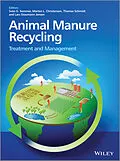A rapidly changing and expanding livestock and poultry production sector is causing a range of environmental problems on local, regional and global scales.
Animal Manure Recycling: Treatment and Management presents an accessible overview of environmentally friendly technologies for managing animal manure more efficiently and in a sustainable manner. The book describes the physical and chemical characteristics of animal manure and microbial processes, featuring detailed examples and case studies showing how this knowledge can be used in practice. Readers are introduced to the sustainable use of animal manure for crop fertilisation and soil amelioration. Environmentally friendly technologies for reducing emissions of ammonia, odour and the greenhouse gases nitrous oxide and methane are presented, and reduction of plant nutrient losses using separation technologies is introduced. Finally and most importantly, the book describes methods to commercialise and transfer knowledge about innovations to end-users.
Topics covered include:
* Regulation of animal manure management
* Manure organic matter: characteristics and microbial transformations
* Greenhouse gas emissions from animal manures and technologies for their reduction
* Technologies and logistics for handling, transport and distribution of animal manures
* Bioenergy production
* Animal manure residue upgrading and nutrient recovery in bio-fertilisers
* Life cycle assessment of manure management systems
* Innovation in animal manure management and recycling
Animal Manure Recycling: Treatment and Management presents state-of-the-art coverage of the entire animal manure chain, providing practical information for engineers, environmental consultants, academics and advanced students involved in scientific, technical and regulatory issues related to animal manure management.
Autorentext
Sven G. Sommer, Institute of Chemical Engineering, Biotechnology and Environmental Engineering, University of Southern Denmark (SDU), Denmark.
Professor Sommer has over fifteen years' experience in international research within all aspects of manure storage and composting processes.
He is currently leading a research group in biosystem technologies at the University of Southern Denmark. Previous studies include: chemical processes and microbial activity affecting gaseous losses of ammonia and greenhouse gases, biogas production and techniques to mitigate greenhouse gas emission (CH4 and N2O) from manure during storage, and development and implementation of efficient and cheap separation techniques.
Morten L. Christensen, Department of Biotechnology, Chemistry and Environmental Engineering, Aalborg University, Denmark.
Thomas Schmidt, Technology Manager, Aarhus University, Denmark.
Lars S. Jensen, Faculty of Life Sciences, University of Copenhagen, Denmark.
Inhalt
List of Contributors xiii
Preface xv
Acknowledgements xvii
1 Animal Manure From Waste to Raw Materials and Goods 1
Sven Gjedde Sommer
References 4
2 Animal Production and Animal Manure Management 5
Sven Gjedde Sommer and Morten Lykkegaard Christensen
2.1 Introduction 5
2.2 Housing, Feedlots and Exercise Areas 7
2.3 Management of Manure 15
2.4 Systems Analysis Method for Assessing Mass Flows 18
2.5 Summary 23
References 23
3 Regulations on Animal Manure Management 25
Sven Gjedde Sommer, Oene Oenema, Teruo Matsunaka and Lars Stoumann Jensen
3.1 Introduction 25
3.2 Environmental Issues 26
3.3 Need for Government Regulations 29
3.4 Global Regulation Multilateral Environmental Agreements 30
3.5 Regional Regulations Exemplified with EU Directives and Regulations 31
3.6 National Regulations on Agricultural Pollution 34
3.7 Summary 38
References 39
4 Manure Characterisation and Inorganic Chemistry 41
Morten Lykkegaard Christensen and Sven Gjedde Sommer
4.1 Introduction 41
4.2 Livestock Manure Categories 42
4.3 Physical Characterisation of Manure 45
4.3.1 Particle Size 45
4.4 Manure Inorganic Chemistry 49
4.5 Summary 63
References 63
5 Manure Organic Matter Characteristics and Microbial Transformations 67
Lars Stoumann Jensen and Sven Gjedde Sommer
5.1 Introduction 67
5.2 Manure Organic Matter Composition 68
5.3 Manure Microbiology 73
5.4 Microbial and Biochemical Transformations in Manure 75
5.5 Transformations of Nitrogen 82
5.6 Summary 87
References 87
6 Sanitation and Hygiene in Manure Management 91
Bj¨orn Vinner°as
6.1 Hygiene Risks Associated with Manure Management 91
6.2 Why Must the Pathogens in Manure be Managed? 92
6.3 Manure Treatment Alternatives 95
6.4 Chemical Treatment 99
6.5 Summary 102
References 103
7 SolidLiquid Separation of Animal Slurry 105
Morten Lykkegaard Christensen, Knud Villy Christensen and Sven Gjedde Sommer
7.1 Introduction 105
7.2 Removal and Separation Efficiency 106
7.3 In-House Separation 107
7.4 SolidLiquid Separation of Manure Slurry 108
7.5 Pre-Treatment: Chemical Additives 119
7.6 Post-Treatment: Separation Techniques 124
7.7 Summary 129
References 129
8 Gaseous Emissions of Ammonia and Malodorous Gases 131
Sven Gjedde Sommer and Anders Feilberg
8.1 Introduction 131
8.2 Characteristics of Ammonia and Hydrogen Sulfide 132
8.3 Processes Involved in Emission 133
8.4 Two-Layer Transport and Release Model 141
8.5 Assessment of Gas Release and Emission 147
8.6 Summary 150
References 151
9 Ammonia and Malodorous Gases: Sources and Abatement Technologies 153
Anders Feilberg and Sven Gjedde Sommer
9.1 Introduction 153
9.2 Measurement Methods 154
9.3 Ammonia Emissions 157
9.4 Odour Emissions 164
9.5 Technologies and Additives to Reduce NH3 and Odour Emissions 167
9.6 Summary 172
References 173
10 Greenhouse Gas Emissions from Animal Manures and Technologies for their Reduction 177
Sven Gjedde Sommer, Tim J. Clough, David Chadwick and Søren O. Petersen
10.1 Introduction 177
10.2 Processes of Methane and Nitrous Oxide Production 179
10.3 Methane Production from Manure 180
10.4 Nitrous Oxide Production from Manure 183
